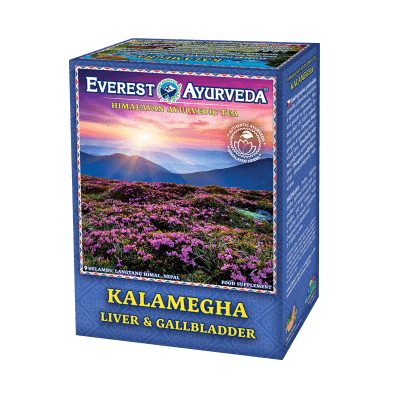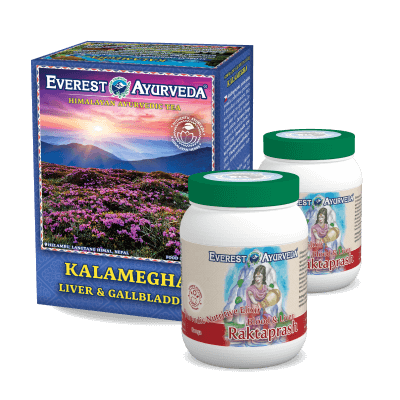
Taking regular care of liver health and cleansing can help us resolve multiple health problems. The liver is a vital organ—a biochemical laboratory that is involved in a wide range of the body's biological functions. One can live without one kidney or one lung, but one cannot live without the liver.
Basic Liver Functions
- Blood formation - recycling of red blood cells (recycling iron that is sent to the bone marrow to produce new blood cells)
- Blood filtration (detoxification) - removes heavy metals and bacteria from the blood
- Digestion - formation of bile (breaking down hemoglobin forms heme, which is used to form bile) and secretion of bile into the stomach to help with digestion (ranjaka-pitta)
- Seat of pitta dosha - the centre of digestive fire for the transformation of ingested food (bhuta agni)
Blood Formation and Recycling of Red Blood Cells
Before birth, red blood cells are formed in the liver and spleen. After birth, this function is taken over by the bone marrow, with which the liver remains closely connected as it supplies recycled iron from old or damaged blood cells to produce new ones. The liver is also a crucial detoxification organ, filtering heavy metals, bacteria, and other unwanted substances from the bloodstream. The spleen, located in close proximity to the liver, serves as a reservoir for blood and plays a vital role in blood filtration and antibody production.
Digestive Function
The liver, together with the stomach, spleen and bone marrow, provides the controlling function of all metabolism. In addition to the recycling of red blood cells, they also ensure the production of bile by breaking down haemoglobin and secreting it into the stomach, where the digestion of food is then carried out properly. Thanks to the liver's activity, we are able to digest alcohol and fats.
Deeper Ayurvedic Perception of the Liver - Ranjaka-Pitta
The liver, called jakrt in Sanskrit (ja means circulation and krt means action) is seen by Ayurvedic medicine as the key seat of pitta dosha, one of the three holistic bioenergies (along with vata and kapha) that make up our physical existence and determine our individual psychosomatic characteristics. Pitta is associated with the element of fire and transformation. Pitta dosha residing in the liver is called ranjaka-pitta. The word "ranjaka" means to colour, and so the ranjaka-pitta controlling the liver affects the colour of the blood, skin, hair and eyes.
Ranjaka-pitta present in the liver breaks down haemoglobin into haem, the non-protein iron part of the enzyme from which bile is formed, and the protein globin. Ranjaka-pitta also resides in the small curvature of the stomach, where it influences the release of vitamin B12, which enters the bloodstream into the bone marrow where it aids in blood formation. If this part of the stomach is surgically removed, it can impair the hematopoietic process and cause anaemia.
Liver and Digestive Fire of Bhuta Agni
Ingested food goes through a digestive process in the stomach, small intestine and large intestine. This process is guided by two types of digestive fire (agni) - the central digestive fire and the so-called bhuta agni, the digestive fire present in the liver.
Bhuta agni takes care of the so-called elemental metabolism, i.e. the conversion of the 5 basic elements contained in the diet into nutrients that are absorbable by the body. Like every living organism, every food consumed consists of various combinations of the 5 elements (air, fire, water, earth and ether) which must be transformed with the help of bhūta agni so that our body is able to digest them and use them to nourish the 7 body tissues (dhatus). Therefore, there are also 5 types of bhoot agni that digest the elements and manifest in the body as specialized enzymes.
For example, through mineral metabolism, which is governed by the earth or mineral fire (parthiva agni), the bones and joints are nourished.
Liver - Seat of Emotions
The liver is also the seat of emotions emanating from the fiery nature of pitta dosha, such as anger, rage, hatred, hostility or jealousy. These emotions need to be processed just like food going through the process of metabolism. Suppressed emotions cause stress in the organs and in the long run can lead to disease. In order for them to be processed and not burden the body, these emotions must be acknowledged and accepted. Read more about emotions in the article Stress and Negative Emotions - Implications and Advice from an Ayurvedic Perspective.
Liver Diseases
There is a connection, an integrity, between the liver, stomach, spleen and bone marrow. If the function of one is impaired, it adversely affects the others. Thus, if the liver is impaired, this also affects the digestive process in the stomach, the production of red blood cells in the bone marrow, the quality of the blood or even the health of the eyes.
Diseases caused by improper liver function include hepatitis, anaemia, chronic fatigue syndrome, appendicitis, jaundice or mononucleosis. You can recognise impaired liver function by the following symptoms: increased temperature, fatigue, heartburn, ovarian problems, cramps during menstruation, red eyes, visual disturbances, headaches, insomnia, aphthae, cold sores, cracked corners, tooth decay and feelings of anger, rage and jealousy.
The most common causes of impaired proper liver function are:
alcohol consumption, use of drugs and chemical medicines, smoking, stress, negative emotions, poor hygiene and blood toxicity, excessive bile production, inappropriate diet in the form of salty, spicy, sour and fried foods, excessive consumption of animal fat or obesity.
Dosha Imbalance Affects Liver Health
Improper lifestyle disturbs the individual psychosomatic balance of the three doshas. Increasing pitta dosha (e.g., by eating spicy foods) increases the intensity of the digestive fire, which causes hypermetabolism. This manifests as overacidity, diarrhea, dry throat, liver pain, uplifted stomach and inflammatory diseases. If the ranjaka-pitta in the liver is disturbed by kapha dosha (a combination of the water and earth elements), gallstones can form, and its prolonged presence in the liver can result in high cholesterol, fatty degeneration of the liver, or steatorrhea (diarrhea with fat in the stool).
The processing of ingested alcohol also causes an increase in pitta dosha, which can manifest as photophobia (hypersensitivity of the eyes to light due to toxicity). Any poisoning of the liver then leads to impaired visual function, including yellowing of the whites, as the eyes and vision are another seat of pitta dosha.
Our tip for Liver Cleansing - Drink Healthy Himalayan Tea!
Liver cleansing is most suitable in spring, when the body naturally wants to get rid of toxins accumulated in the body during the winter period, which is more mentally demanding and characterized by less exercise, higher dietary intake, cold and stress. Ayurvedic preparations for liver detoxification should be taken regularly twice a day for a month.
- Himalayan Ayurvedic Tea Kalamegha
- Nutritive Herbal Elixir Raktaprash
- Ayurvedic Health Therapy Blood & Liver Detox
- Ayurvedic Amla Drink Turmeric
Read more about the use of the preparations in the article Join the Ayurvedic Purification V. - Liver & Blood.

 100 g
100 g  200 g
200 g 
 100 g
100 g